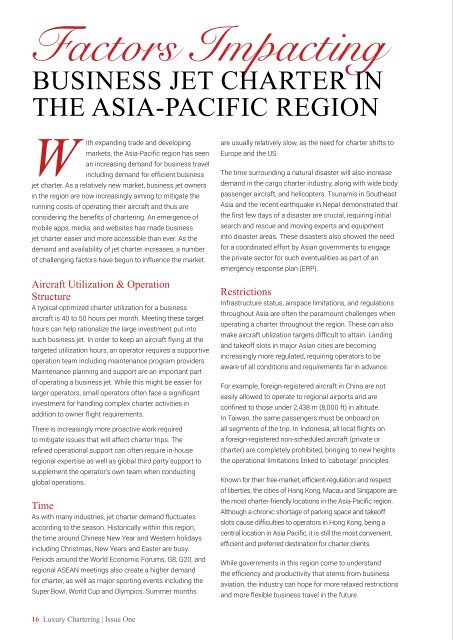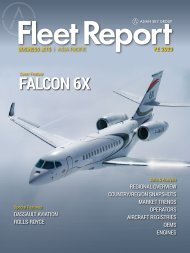Create successful ePaper yourself
Turn your PDF publications into a flip-book with our unique Google optimized e-Paper software.
Factors Impacting<br />
BUSINESS JET CHARTER IN<br />
THE ASIA-PACIFIC REGION<br />
W<br />
ith expanding trade and developing<br />
markets, the Asia-Pacific region has seen<br />
an increasing demand for business travel<br />
including demand for efficient business<br />
jet charter. As a relatively new market, business jet owners<br />
in the region are now increasingly aiming to mitigate the<br />
running costs of operating their aircraft and thus are<br />
considering the benefits of chartering. An emergence of<br />
mobile apps, media, and websites has made business<br />
jet charter easier and more accessible than ever. As the<br />
demand and availability of jet charter increases, a number<br />
of challenging factors have begun to influence the market.<br />
Aircraft Utilization & Operation<br />
Structure<br />
A typical optimized charter utilization for a business<br />
aircraft is 40 to 50 hours per month. Meeting these target<br />
hours can help rationalize the large investment put into<br />
such business jet. In order to keep an aircraft flying at the<br />
targeted utilization hours, an operator requires a supportive<br />
operation team including maintenance program providers.<br />
Maintenance planning and support are an important part<br />
of operating a business jet. While this might be easier for<br />
larger operators, small operators often face a significant<br />
investment for handling complex charter activities in<br />
addition to owner flight requirements.<br />
There is increasingly more proactive work required<br />
to mitigate issues that will affect charter trips. The<br />
refined operational support can often require in-house<br />
regional expertise as well as global third party support to<br />
supplement the operator’s own team when conducting<br />
global operations.<br />
Time<br />
As with many industries, jet charter demand fluctuates<br />
according to the season. Historically within this region,<br />
the time around Chinese New Year and Western holidays<br />
including Christmas, New Years and Easter are busy.<br />
Periods around the World Economic Forums, G8, G20, and<br />
regional ASEAN meetings also create a higher demand<br />
for charter, as well as major sporting events including the<br />
Super Bowl, World Cup and Olympics. Summer months<br />
16 <strong>Luxury</strong> <strong>Chartering</strong> | Issue One<br />
are usually relatively slow, as the need for charter shifts to<br />
Europe and the US.<br />
The time surrounding a natural disaster will also increase<br />
demand in the cargo charter industry, along with wide body<br />
passenger aircraft, and helicopters. Tsunamis in Southeast<br />
Asia and the recent earthquake in Nepal demonstrated that<br />
the first few days of a disaster are crucial, requiring initial<br />
search and rescue and moving experts and equipment<br />
into disaster areas. These disasters also showed the need<br />
for a coordinated effort by Asian governments to engage<br />
the private sector for such eventualities as part of an<br />
emergency response plan (ERP).<br />
Restrictions<br />
Infrastructure status, airspace limitations, and regulations<br />
throughout Asia are often the paramount challenges when<br />
operating a charter throughout the region. These can also<br />
make aircraft utilization targets difficult to attain. Landing<br />
and takeoff slots in major Asian cities are becoming<br />
increasingly more regulated, requiring operators to be<br />
aware of all conditions and requirements far in advance.<br />
For example, foreign-registered aircraft in China are not<br />
easily allowed to operate to regional airports and are<br />
confined to those under 2,438 m (8,000 ft) in altitude.<br />
In Taiwan, the same passengers must be onboard on<br />
all segments of the trip. In Indonesia, all local flights on<br />
a foreign-registered non-scheduled aircraft (private or<br />
charter) are completely prohibited, bringing to new heights<br />
the operational limitations linked to ‘cabotage’ principles.<br />
Known for their free-market, efficient-regulation and respect<br />
of liberties, the cities of Hong Kong, Macau and Singapore are<br />
the most charter-friendly locations in the Asia-Pacific region.<br />
Although a chronic shortage of parking space and takeoff<br />
slots cause difficulties to operators in Hong Kong, being a<br />
central location in Asia Pacific, it is still the most convenient,<br />
efficient and preferred destination for charter clients.<br />
While governments in this region come to understand<br />
the efficiency and productivity that stems from business<br />
aviation, the industry can hope for more relaxed restrictions<br />
and more flexible business travel in the future.<br />
Charter Users<br />
There are a number of typical business jet charter clients<br />
throughout the region, with casino operators being arguably<br />
the largest. Such companies have historically acquired<br />
their own aircraft to maximize their chances of attracting<br />
highly-roller clientele. The rationalization of costs in the<br />
casino segment has arguably played a large role in the<br />
recent resurgence of block charter demand (buying blocks<br />
of hours at a time) in<br />
and out of Singapore,<br />
as well as Macau.<br />
The Philippines<br />
is also beginning<br />
to see a need for<br />
supplemental block<br />
charter.<br />
Fortune 500 and<br />
multinational<br />
companies are<br />
also increasingly<br />
becoming regular users of business jet charter services,<br />
being typical from the entertainment or real estate<br />
industries, government agencies and commodity<br />
firms, among others. As the demand from Fortune 500<br />
companies in this region is strengthening, such companies<br />
commonly want to ensure operators have all the necessary<br />
international-level qualifications. This would include<br />
international charter certifications: IBAC’s IS-BAO stage I,<br />
II, or III, Wyvern Wingman, ARGUS Gold or Platinum, or the<br />
Flight Safety Foundation’s (FSF) BARS audit. Business jet<br />
operators will not have all certifications, but most will have<br />
two or three to reassure clients about their efficient and<br />
safe flight operations.<br />
Charter Products<br />
As the demand for business jet charter increases throughout<br />
the Asia-Pacific region, the services continues to evolve,<br />
creating numerous options for users. The most popular<br />
option for chartering a jet is on-demand, which allows use<br />
when needed with no commitment and a pay-as-you-go<br />
structure. To secure preferred rates and availability, block<br />
hour programs are becoming increasingly popular, offering<br />
a guaranteed discounted rates and priority treatment – or<br />
blocks – to be used within a period of time. A number of<br />
companies are also offering charter card programs, which<br />
requires an initial fee but provides a guaranteed hourly rate.<br />
The card program also works on an on-demand basis. As<br />
many programs vary in their advantages and conditions,<br />
it is best to research which solution is best suited to one’s<br />
requirements. A description of most prevalent Asia-Pacific<br />
membership programs and mobile applications active is<br />
presented further in this report.<br />
Aviation Professionals<br />
While demand for business aviation services rises, there<br />
is a growing concern regarding the shortage of aviation<br />
professionals in the region. According to the International<br />
Civil Aviation Organization (ICAO), “the Asia-Pacific region<br />
will need 216,000 new pilots in the next 20 years, more than<br />
in any other part of the world, accounting for 40 percent of<br />
the global demand.” The shortage of aviation professionals<br />
also applies to the business aviation industry, and does not<br />
stop with pilots.<br />
Mechanics and engineers, who tend to flock toward the<br />
train and automobile industry, ask for higher salaries<br />
in order to join the business aviation industry. The<br />
difficulty of employing these types of professionals also<br />
creates a burden for companies employing them. The<br />
initial investment required to train certified flight crews,<br />
mechanics, and dispatchers is not only high, but also<br />
does not guarantee that such resources will gather<br />
the necessary standards and experience to provide a<br />
sustainable base to the local industry.<br />
Business Aviation Industry<br />
Although challenges within the charter industry will<br />
ARTICLE<br />
continue to arise, Asia – with its large population and<br />
wealth – is in a good position to quickly tackle flexibility<br />
issues to empower efficient business travel throughout<br />
this rapid-growth region. Organizations including ASEAN<br />
and APEC working with the International Civil Aviation<br />
Organization (ICAO), the International Business Aviation<br />
Council (IBAC) and the Asian Business Aviation Association<br />
(AsBAA) continuously raise the importance of improving<br />
transportation regulations in an effort to implement<br />
efficient solutions.<br />
<strong>Luxury</strong> <strong>Chartering</strong> | Issue One 17

















